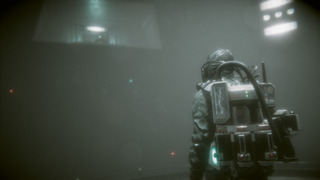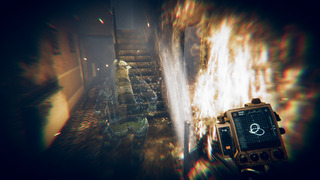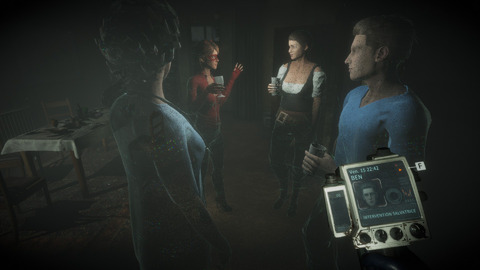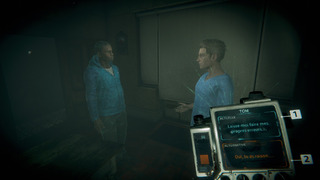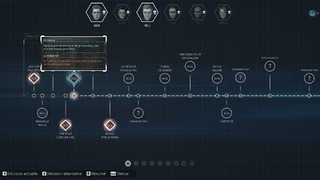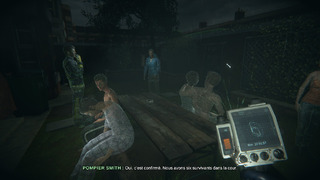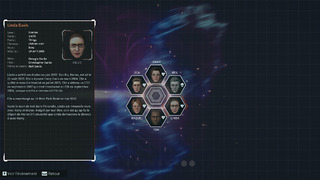Who has never wanted to be able to go back in time to correct a mistake of the past? It is this idea that serves as the starting point for Eternal Threads. But between an idea and a game, there is a world that the simple flapping of a butterfly’s wing can transform.
Fight fire with fire
The ability to time travel may be the dream of many, but for the scientists of the Second Chance Initiative, it’s the only way to save the future. Because early time travel experiments were poorly mastered, the time flow was greatly altered, leading to the post-apocalyptic world in which the game begins. To try to restore the normal course of time, it is therefore necessary to send someone in the past to correct certain precise events. That someone is you and your mission is to save 6 people who initially died in a fire.
Life at 6
Allow me to briefly introduce you to the 6 characters with whom you spend about ten hours. Tom, first of all, is the owner of the house, the rooms of which he rents to pay for the care of his sick mother. Ben and Jen next. A couple, he a future doctor and she a math student. Next comes Raquel, a young painter and old friend of Jen. And finally Neil, the most secretive of the gang whose sister Linda has just moved in to escape a failing marriage. If you find that this casting does not look crazy, you are totally correct, it is one of the problems of the game.
damn butterfly
Let’s resume. So you land in the entrance hall of the house, the night following the fire. With a simple press of a button, you can bring up the timeline of the previous seven days. On this frieze, you can visualize each node representing an event of the past week. Some are available immediately, others are potential events that may occur if you modify the timeline correctly. Choose an available event and let the gadget in your hand guide you to the room where you can view the corresponding scene. In some of these scenes, your viewer detects an anomaly, which gives you a choice between two orientations to give to the scene, modifying the scene in real time and opening or closing certain nodes on the timeline.
Seemingly easy mechanics, but a first difficulty awaits you: you do not have immediate access to all the rooms of the house. Some doors are closed, so you need to view the correct events to find out where the keys to the closed areas are hidden. On the other hand, it is welcome that it is not necessary to retype the entirety of a scene to test the alternative. Once a scene has been viewed for the first time, the possibility of changing its course is directly available on the timeline. However, this does not prevent an unpleasant feeling of deja vu from setting in after a few hours of play.
Secret Story
When I introduced you to the game’s protagonists, I told you that one of the game’s problems was with its cast. The explanation is unfortunately simple. Following the daily life of the inhabitants of the house is like watching an episode of reality TV: it is rarely exciting and often without interest. The sequences are also far too numerous. The game announces no less than 197 in its normal mode (a simplified mode also exists, with fewer sequences, but it will prevent you from obtaining the optimal ending), but only 54 require you to make a decision. Problem, some of these sequences are only tiny variations according to a previous decision. Depending on whether Linda chooses to drink or stay sober at a party, you will later have the same event, the only difference being Linda’s blood alcohol level, for example.
Two other elements weigh down the principle a little more. Some events are practically inevitable at first, the best you can influence when they will take place (which is not insignificant, let’s give this point to the game). Which, again, duplicates sequences on the timeline of time. Finally, we quickly notice that some decisions have in fact no consequence, which is a big blow to the narrative ambitions of the title. To keep us awake, the game tries to sell us a big mystery, which you normally discover halfway through. Unfortunately, this mystery also leads to a final sequence that frustrates more than it adds to the overall narrative. Caramba, failed again.
No one will remember this
There is one last element of the game that we need to talk about: the ergonomics of its interface. You understood it with the preceding paragraphs, 197 sequences, it is much. Presenting this in a legible way on the timeline is a challenge that the game only half succeeds. It is possible to simply switch from one day to another or even to filter the events by roommate, which allows you to approach the game as you wish. We can therefore choose to follow a specific character or view the events in chronological order, both options are viable. Similarly, one can, with the simple pull of a trigger, select a decision and highlight all the consequences that flow from it, then go through them with the stick. A plus for navigation in the frieze.
It is however regrettable that the game does not have any option to memorize a global state of the timeline, which one could reload to restore it after having tested other decisions. The game does indeed include a very frequent automatic backup. Annoying when you know that when you modify a decision node, all the nodes that derive from it are reset to their default state, which forces you more than once to go through a whole chain of consequences to restore the optimal choices you had already done. It’s quite heavy.
A technique that is not futuristic
From a technical point of view, Eternal Threads clearly isn’t the prettiest we’ve seen. Most of the action taking place at night, the scenes are often poorly or badly lit, which highlights the ghostly aspect of the characters whose daily lives we follow. On the other hand, the game is not very demanding, both in terms of disk usage (less than 10GB) and machine specifications, it should run smoothly on PCs that are several years old. Strange all the same that the game suffers from a systematic slowdown at the end of the first sequence following the launch of the game, it surprises the first time. On the audio side finally, it will be necessary to be satisfied with a subtitled OV.
Eternal Threads started with a good idea, but Cosmonaut Studio failed at the most important step in a narrative game: getting a good story out of it. The result is a story that’s too flat for a game that’s far too long for its own good. It is therefore difficult to recommend Eternal Threads to you rather than a classic narrative game or even an FMV perhaps more linear in its principle, but perhaps also more daring in what it has to tell.
Test carried out by Grim on PC using a version provided by the publisher.
.
[related_posts_by_tax taxonomies=”post_tag”]
The post Eternal Threads Review – Seven Days to Act appeared first on Gamingsym.

